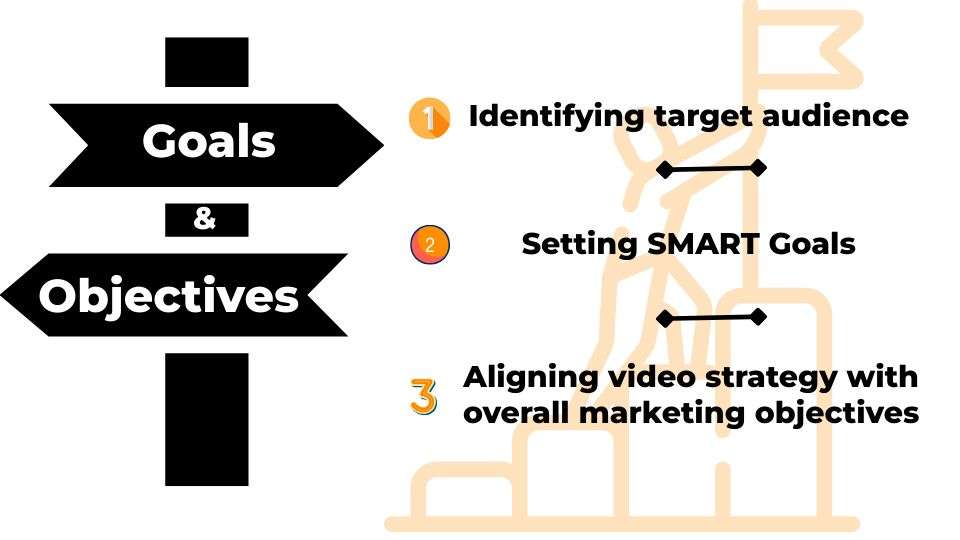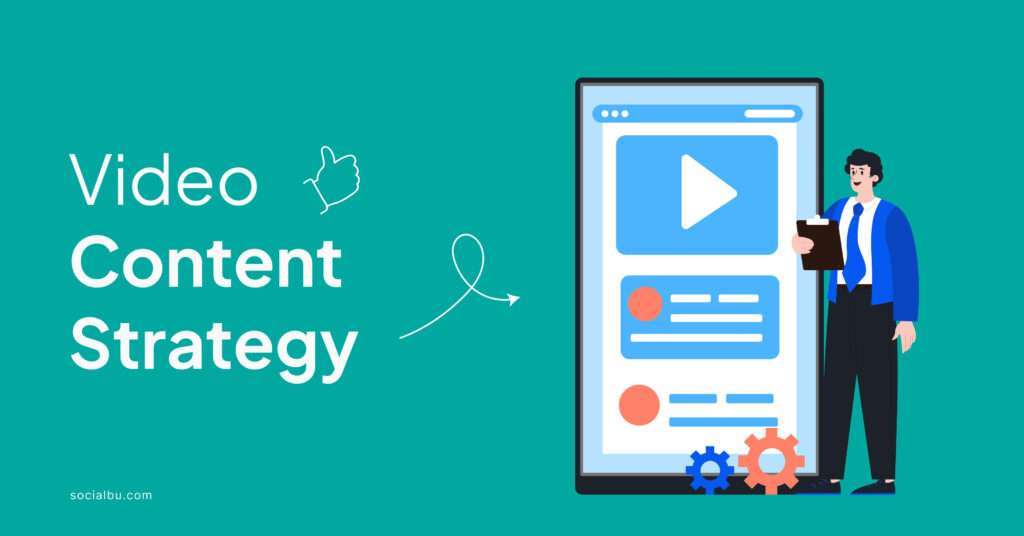You’ve just spent weeks crafting the perfect video for your brand, but it’s barely getting any views. Sound familiar? You’re not alone. 60% of marketers report that their biggest video marketing challenge is generating enough views and engagement. This stark reality reveals a critical truth: creating great video content is only half the battle. The other half is a rock-solid video content strategy.
But why is this so crucial now? The answer lies in evolving consumer behavior. People are spending just so much time watching videos. This shift presents an opportunity for brands to connect with their audience in meaningful ways.
Our guide is designed to explain a step-by-step process to develop a strategy that not only increases your video’s reach but also drives real business results.
Step 1: Define Your Goals and Objectives

When learning how to create a video content strategy, the first crucial step is to define your goals and objectives. It will guide all your future decisions and help measure your success.
1. Identifying Target Audience
Before you start creating videos, you need to know who you’re making them for, so you should analyze these factors of your target audience.
- Demographics: Age, gender, location, income level
- Psychographics: Interests, values, lifestyle
- Online behavior: Preferred platforms, viewing habits
Understanding your audience’s preferences will help you create content that resonates with them and drives engagement.
2. Setting SMART Goals
SMART goals provide a clear framework for your video content strategy. By “SMART,” we mean:
- Specific: Clearly define what you want to achieve
- Measurable: Establish concrete criteria for measuring progress
- Achievable: Set realistic and attainable goals
- Relevant: Ensure goals align with your overall business objectives
- Time-bound: Set a timeframe for achieving your goals
For example, a SMART goal could be: “Increase website traffic from video content by 25% within the next six months.”
3. Aligning Video Strategy with Overall Marketing Objectives
Your video content strategy should support your broader marketing efforts. Consider how your video can complement:
- Brand awareness campaigns
- Lead generation efforts
- Customer retention programs
Integrating video into your overall marketing strategy can significantly enhance your brand’s online presence and engagement with your audience.
By defining clear goals and objectives, you lay a solid foundation for your video content strategy. This clarity will guide your content creation, distribution, and measurement efforts, ensuring your videos contribute meaningfully to your business objectives.
Step 2: Research Your Target Audience
Another crucial aspect of your video content strategy is thoroughly understanding your audience. This knowledge will help you create content that truly resonates with your viewers.
1. Creating Audience Personas
Audience personas are fictional representations of your ideal viewers. To create these:
- Gather demographic data: Age, gender, location, income
- Identify professional information: Job titles, industries, company sizes
- Understand personal details: Hobbies, interests, challenges
Developing 2-3 detailed personas will guide your content creation process. These personas will help you tailor your videos to specific audience segments.
2. Analyzing Viewing Habits and Preferences
Understanding how your audience consumes video content is crucial. To do this, you should consider analyzing these factors.
- Preferred platforms: YouTube, Instagram, TikTok, or others
- Viewing times: When is your audience most active online?
- Device usage: Do they prefer mobile, desktop, or smart connected TV viewing?
92.3% of internet users worldwide watch videos online each week. This highlights the importance of understanding your audience’s viewing habits in your video content strategy.
3. Identifying Pain Points and Interests
To create valuable content, you need to understand:
- Challenges that your audience faces
- Questions they frequently ask
- Topics they’re most interested in
You can gather all this information through surveys, social media listening, customer feedback, and industry forums.
88% of the most successful content marketers prioritize audience needs over promotional messages. This approach can significantly improve the effectiveness of your video content strategy.
By thoroughly researching your target audience, you can create video content that not only attracts viewers but also engages them in a meaningful way.
Remember, audience research isn’t a one-time task, so you should regularly update your analytics to keep your video content strategy aligned with your audience’s evolving preferences and needs.
Step 3: Choose Your Video Types and Formats

When developing your video content strategy template, selecting the right types and formats of videos is crucial. Different video styles serve various purposes and appeal to different audience segments. Let’s explore some popular video types you can incorporate into your strategy:
1. Explainer Videos
Explainer videos are short, engaging animations or live-action clips that simplify complex ideas or products, making them easier to understand. They typically:
- Last 60-90 seconds
- Use simple language and visuals
- Address a specific problem and solution
96% of people have watched an explainer video to learn more about a product or service.
2. Product Demonstrations
Product demos showcase your products or services in action. These videos:
- Highlight key features and benefits
- Show real-world applications
- Address common customer questions
Consider modern tools, such as an AI face swap tool, for creative content production and personalization at scale.
3. Customer Testimonials
Testimonial videos feature satisfied customers sharing their experiences. They:
- Build trust and credibility
- Provide social proof
- Address potential customer concerns
4. Behind-the-Scenes Content
These videos offer a glimpse into your company culture or processes. They can:
- Humanize your brand
- Increase transparency
- Foster a connection with your audience
5. Live Streams
Live streaming has gained significant popularity. It allows for:
- Real-time interaction with your audience
- Immediate feedback and Q&A sessions
- Creating a sense of urgency and exclusivity
6. Webinars and Tutorials
Educational content, like webinars and tutorials, positions your brand as an industry expert. They:
- Provide in-depth knowledge on specific topics
- Attract leads interested in your area of expertise
- Offer value to your audience beyond your products
When creating your video content strategy template, consider incorporating a mix of these video types to maximize effectiveness. This variety will help you engage different segments of your audience and achieve various marketing objectives.
By thoughtfully selecting and balancing these video formats in your content strategy, you’ll create a diverse and engaging video portfolio that resonates with your audience and drives your marketing objectives forward.
Step 4: Develop a Content Calendar

A well-structured content calendar is crucial for maintaining consistency in your video marketing efforts. The importance of video marketing cannot be ignored, and a content calendar helps you stay organized and strategic.
1. Planning Video Topics and Themes
- Brainstorm ideas aligned with your goals
- Consider seasonal trends and industry events
- Balance the different video types we discussed above
2. Scheduling Production and Release Dates
- Set realistic timelines for video creation
- Plan for pre-production, filming, and editing
- Consider optimal posting times for your audience
3. Aligning with Marketing Campaigns and Seasonal Trends
- Coordinate video content with other marketing initiatives
- Plan for major holidays and industry-specific events
- Create themed content series for extended engagement
A well-planned content calendar helps maximize ROI by ensuring consistent and timely content delivery.
Step 5: Optimize for SEO and Social Platforms

Optimizing your videos for search engines and social media platforms is crucial to maximize their reach and impact. This step further emphasizes the importance of video marketing in your overall strategy.
1. Keyword Research for Video Titles and Descriptions
- Utilize tools like Google Keyword Planner for research purposes. Alternatively, consider partnering with a professional SEO agency for a keyword strategy tailored to your video content.
- Include relevant keywords in titles and descriptions
- Create compelling, click-worthy titles
2. Creating Engaging Thumbnails
- Design eye-catching thumbnails that represent video content
- Use high-contrast colors and explicit imagery
- Include text overlays when appropriate
3. Implementing Video SEO Best Practices
- Add closed captions and transcripts
- Use tags and categories effectively
- Create video sitemaps for your website
4. Crafting Shareable Content for Social Media Platforms
- Adapt video length and format for each platform
- Use platform-specific features (e.g., Instagram Reels, YouTube Shorts)
- Include a clear call-to-action in your videos.
A report by Cisco predicts that by 2023, video will represent 82% of all internet traffic. This statistic highlights the significance of video marketing and the necessity for effective optimization.
These steps ensure your content reaches the right audience at the right time, maximizing engagement and return on investment.
Step 6: Invest in Quality Production

High-quality video production is essential for creating engaging content that resonates with your audience. Let’s explore the key aspects of quality production:
1. Equipment Essentials
Review the following list of equipment for the highest quality video production.
- Cameras: Select a camera that suits your budget and requirements. Options range from smartphones to professional-grade cameras.
- Microphones: Good audio is crucial. Invest in a quality external microphone for clear sound.
- Lighting: Proper lighting can significantly improve video quality. Consider LED panel lights or ring lights.
2. Scripting and Storyboarding
- Write clear, concise scripts for your videos
- Create storyboards to plan visual elements
- Ensure your content aligns with your overall strategy
3. Hiring Professionals vs. In-House Production
- Assess your team’s capabilities and resources
- Consider hiring remote staffing agencies to outsource for specialized skills
- Weigh the costs and benefits of each approach
4. Maintaining Brand Consistency
- Use consistent color schemes and graphics
- Incorporate your logo and brand elements
- Ensure your brand voice is consistent across all videos
Step 7: Choose the Right Distribution Channels

Selecting appropriate distribution channels ensures your videos reach your target audience effectively.
1. YouTube Strategy
- Create a branded channel
- Optimize video titles, descriptions, and tags
- Use playlists to organize content
- Engage with viewers through comments
2. Social Media Platforms
- Facebook: Use native video uploads for better reach
- Instagram: Leverage IGTV for longer content and Reels for short-form videos
- TikTok: Create trending, engaging short-form content
3. Embedding Videos on Your Website
- Improve website engagement and time on page
- Boost SEO with video content
- Use video landing pages for specific campaigns
4. Email Marketing with Video Content
- Include video thumbnails in email newsletters
- Use “video” in subject lines to increase open rates
- Link to landing pages with embedded videos
A study by Campaign Monitor found that including the word “video” in an email subject line can increase open rates by 19%.
By investing in high-quality production and selecting the optimal distribution channels for video marketing, you’ll establish a solid foundation for your video marketing efforts. Remember to consistently analyze the performance of your videos across different platforms and adjust your strategy accordingly.
Step 8: Measure and Analyze Performance

Measuring and analyzing your video content performance is crucial for refining your strategy and improving future content. This step helps you understand what works and what doesn’t, allowing you to make data-driven decisions.
1. Key Video Metrics to Track
Focus on these essential metrics to gauge your video content’s success:
- Views: This fundamental metric indicates the number of times your video has been watched. While important, it doesn’t tell the whole story.
- Engagement Rate: This includes likes, comments, and shares. A high engagement rate suggests your content resonates with your audience.
- Watch Time: This metric indicates the average duration viewers spend watching your videos. Longer watch times typically indicate more engaging content.
- Click-Through Rate (CTR): If your video includes a call-to-action, track how many viewers follow through. This metric directly ties to your video’s effectiveness in driving action.
- Conversion Rate: Ultimately, you want to know if your videos are contributing to your business goals. Track how many viewers take desired actions after watching your videos.
2. Using Analytics Tools
Leverage platform-specific analytics tools to gather detailed insights:
- YouTube Analytics: This tool provides comprehensive data on your video performance, audience demographics, and engagement metrics.
- Google Analytics: Utilize this tool to monitor the impact of video content on your website traffic and conversions.
- Social Media Insights: Each social media platform offers its analytics tools. Use these to understand how your videos perform on different channels.
3. A/B Testing for Continuous Improvement
Implement A/B testing to optimize your video content:
- Test different video lengths to find what works best for your audience.
- Experiment with various thumbnail designs to improve click-through rates.
- Try different call-to-action to see which drives the most conversions.
Step 9: Repurpose and Recycle Content

Repurposing your video content maximizes your investment and extends your reach across different platforms and formats.
1. Creating Shorter Clips for Social Media
Break down longer videos into bite-sized clips for platforms like Instagram or TikTok. This approach caters to shorter attention spans on these platforms while promoting your full-length content.
2. Transcribing Videos for Blog Posts
Turn your video content into written blog posts. This not only provides value for those who prefer reading but also boosts your SEO efforts. Include the video embedded in the blog post for a multimedia experience.
3. Turning Webinars into Downloadable Guides
Transform informative webinars into comprehensive guides or e-books. This gives your audience a valuable resource they can reference repeatedly, potentially increasing lead generation.
4. Updating and Refreshing Older Video Content
Don’t let your older videos go to waste. Update them with new information, improve the quality if needed, and re-release them. This strategy can breathe new life into evergreen content.
59% of marketers reuse content two to five times. This approach ensures you get the most value from your video production efforts.
By consistently measuring your video performance and creatively repurposing your content, you’ll continually improve your video marketing strategy. These steps help you maximize the return on your video investment while providing valuable content to your audience across various formats and platforms.
Conclusion
Creating a successful video content strategy requires careful planning, execution, and analysis. By following these nine steps, you can develop a strong approach that engages your audience and drives results.
Remember, a great video content strategy is not static; it evolves based on performance data and audience feedback. Stay flexible, keep testing new ideas, and always prioritize delivering value to your viewers. With consistency and dedication, your video content strategy will become a powerful tool in your marketing arsenal.
If you want to improve your video content strategy further, SocialBu can help you manage and analyze your video content across multiple platforms. Sign up for a free trial today and see how our tools can streamline your video marketing efforts.
FAQs
1. What is a video content strategist?
A video content strategist is a professional who plans, develops, and manages video content to achieve specific marketing or communication goals. They analyze audience needs, create video concepts, and oversee production to ensure content aligns with brand objectives and resonates with viewers.
2. How to make great video content?
To make great video content, focus on telling a compelling story, understand your target audience, use high-quality visuals and audio, keep it concise, and include a clear call-to-action. Ensure the content provides value and is optimized for the platform where it will be shared.
3. What are the seven steps in creating a content strategy?
The seven steps in creating a content strategy typically include:
- Define goals
- Research audience
- Conduct content audit
- Choose content types and channels
- Create a content calendar
- Produce and publish content
- Measure and analyze results
4. What are the 3 components of content strategy?
The three main components of content strategy are:
- Brand Strategy (messaging, tone, voice)
- Content Design (creation, curation, management)
- Content Distribution (channels, promotion, measurement)
5. How do you write a video strategy?
To create an effective video strategy, define your goals, identify your target audience, determine the types and themes of videos, plan your production process, select distribution channels, allocate a budget, and establish metrics for measuring success. Include a content calendar and guidelines for maintaining consistency across videos.
6. How to generate video content?
To generate video content, start by brainstorming ideas that align with your goals and your audience’s interests. Use a mix of original footage, stock videos, animations, and user-generated content. Leverage tools like smartphones for recording editing software for post-production, and consider collaborating with influencers or experts in your field.







